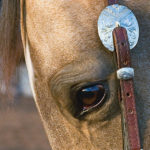When you take your horse out on trails, chances are you expect to have a fun, safe, relaxing time. And most of the time, that expectation is fulfilled. Yet as soon as you leave the relative safety of an arena and its controlled environment, you’re in potential-mishap territory (true, whether you’re half a mile or half a day’s ride from home). That’s why it can really pay to be prepared, with “just in case” items stashed in a small grab-and-go emergency bag and carried on your saddle for every trail ride.

Here, to get you started, I’ll share typical contents of the soft-sided emergency bag (it’s red for a reason!) that’s as much a part of my standard trail-riding gear as my horse’s bridle and saddle. While not as extensive as the emergency gear that might be toted by a search-and-rescue deputy, this stash of items will get you and your horse (or that of a friend) through most minor trail traumas. You can add other items as you like, and as your climate and terrain might call for.
Bag Contents
- Duct tape. Multiple uses, from protecting a hoof that’s lost its shoe to emergency tack repairs.
- Elastic and cling-type wraps. Joint support, bandaging.
- Reflective “space blanket.” Preserves body heat, makes a ground cover.
- LED flashlight. Multiple uses (especially if you get caught out after dark).
- Filled water bottle. Many uses, from hydration or cooling to flushing a wound.
- Stethoscope. For monitoring vital signs, gut sounds.
- Coach’s whistle. Makes piercing blasts to call for help.
- Latex gloves. Hand coverage for wound treatment.
- Banamine paste. Help for colic symptoms.
- Personal first-aid pouch. Holds gauze pads, stick-on bandages, aspirin, bee-sting pen, safety pins, etc.
- Contact-lens solution. Flushes eye or wound debris.
- Bandage scissors. Trims bandaging materials.
- Multi-tool. Multiple uses.
- Hand sanitizer. Helps prevent infection when treating wounds.
- First-aid cream. Antibiotic and antiseptic properties.
Extra Tips
- For his comfort, balance weight carried on one side of your horse with an equally weighted load on the other side.
- Use the multiple pockets of a fishing or hunting vest as an alternative way to carry emergency items.
- For taking pulse/respiration rates, wear a watch that counts seconds (for rate per minute, monitor vital sign for 15 seconds, multiply by four).
This article originally appeared in the March 2010 issue of Horse & Rider.





